World Bee Day ... save the bees!
Synopsis : Bentleys, beewash, robotic hives and why most initiatives are trying to save the wrong bees. Something for everyone for World Bee Day tomorrow.
Introduction
The Bentley Continental GTC convertible is a fantastic example of a luxury car. Gorgeous inside, with split leather upholstery, a 46-speaker Hi-Fi system and the very finest wooden veneer finished with unobtainium trim. Stunning outside, with a gloss carbon fibre body kit and lashings of ‘racetrack attitude’ {{1}}.
And the performance!
The 6 litre, 650 bhp engine delivers 900 Nm of torque, giving a 0-60 mph time of just 3.6 seconds and a top speed in excess of 200 mph.
Of course, all that performance comes at a cost … the fuel consumption is at best ~20 mpg and the CO2 emissions exceed 300 g/km {{2}}.
Those last two figures are unlikely to trouble most purchasers, but – as the world races towards exceeding the 1.5°C threshold by 2027 – they do contribute to climate change.
Fortunately, Bentley are doing their bit to reduce the carbon footprint (of manufacture {{3}} ); the Crewe factory site has been certified carbon neutral since 2019 and they’ve created a ‘green wall’ containing 2600 plants to filter out toxins and dust, which also produces 40 kg of oxygen a year {{4}}.
And, of course, they’ve also got bees.
If you are serious about contributing to biodiversity and ecosystem services, like pollination, you get bees … and, naturally (no pun intended), by doing that you’re also ’saving the bees’.
Bentley have about 10 hives at Crewe, housing some very yellow looking ‘British Apis Mellifera’ (sic) that produce about 200 jars of honey a year.
But it’s not just Bentley who are ’saving the bees’.
Save the bees
Hang on.
Which bees?
Almost always, when a company mentions something about saving the bees, they mean honey bees.
Specifically Apis mellifera.
There are businesses that can provide managed hives. For a fee (often considerable) the hosting company can claim they’re doing their bit for ‘biodiversity and the environment’.
Some beekeeping associations even got in on the act, with ‘sponsor a hive’ initiatives and it turns out there are also a load of sponsor a hive commercial companies out there as well.
There’s an entire industry aiming to ‘save the bees’ by introducing new beehives into the environment, filling them with honey bees and managing them for profit (Oh yes … and the environmental benefits blah, blah, blah.).
But it doesn’t stop there.
Honey bees are so threatened (apparently) that there are other businesses also helping save them. And, frankly, the finances here make plonking a few National hives outside a factory in Crewe seem like tokenism.
I’m not going to provide an exhaustive review of these … it’s all a bit depressing and they’re all much of a muchness.
How about Beewise, the creator of the first-in-class robotic autonomous smart beehive?
Total funding (as of late 2022) was about $120 million. They claim to save the bees (obviously), improve yields and improve pollination.
Undoubtedly the technology – like the Bentley – is very impressive. Automatic inspection and imaging of each frame, automated swarm control and non-chemical Varroa control.
How do they remove, image and return frames without squashing bees?
How do they do swarm control?
And how effective is their non-chemical mite control?
No details I’m afraid, and I didn’t look too carefully as my cynicism got the better of me.
Do these bees – meaning honey bees – need saving?
The chosen few one
Honey bees belong to the genus Apis. The word Apis actually means ‘bee’ (though, as we’ll see, there are lots of other bees as well that are not members of the genus Apis). Apis mellifera – the honey bee almost all readers of this site will manage – is the western honey bee.
Other members of the genus Apis also collect and store nectar which humans exploit. They also all do waggle dances and I’ve previously listed them when discussing the evolutionary conservation of these dances.
However, there are only 8 extant species of honey bee {{5}} and only Apis mellifera gets any attention in these ‘save the bees’ initiatives.
Honey bees (i.e. the genus Apis) actually represent only 0.04% of the world’s bee species.
There are over 20,000 bee species globally, with only Apis sp., the eusocial bumblebees (e.g. Bombus) and solitary polyester bees (e.g. Colletes) – together accounting for ~4% of total species – being even vaguely well-studied.
The global distribution of bees has recently been exhaustively mapped (Orr et al., 2021). It is very uneven (a “bimodal latitudinal gradient” since you asked), with some regions having lots of species, and others – surprisingly including many tropical environments – with very few.
Why does the focus on Apis mellifera matter?
Well, by concentrating on just one of the 20,355 known species, we are ignoring the remainder … and we might even be causing additional damage to some of the other 20,354 species.
Whataboutism
But what about Colony Collapse Disorder of honey bees?
What about the excessively high annual overwinter colony losses of honey bees?
What about the shortages of honey bees to pollinate almond crops?
And what about all those nasty pests and parasites that threaten our beloved honey bees?
Part of the reason we are so aware of the threats to honey bees is, a) because humans have lived alongside (and managed) honey bees for millennia, and – inevitably, and as a consequence of this – b) their economic importance means that we have studied them extensively.
I’m not claiming that honey bees don’t face challenges, but I am saying that the other 99.96% of bees probably face many of the same challenges … and possibly additional ones due to our single-minded focus on honey bees.
Loss of habitat, climate change, pesticides etc. are all equal opportunity environmental threats.
What’s more, many of these threats may well be a lot more damaging to bee species other than honey bees.
The latter are generalists. They’ll happily visit oil seed rape, lime, blackberry and clover, collecting nectar and pollen from each.
But many bees are specialists. There are 14 Colletes species that almost exclusively visit flowers of the Asteroideae family (Müller & Kuhlmann, 2008). Remember, these Colletes bees are some of the best studied. There’s another 19,521 species that we know little or nothing about.
If you’re a specialist solitary pollinating bee that has co-evolved over millions of years, visiting a very narrow range of flower species, then your long-term prospects don’t look too promising if the flowers start blooming earlier and earlier due to climate change (‘de-synchronization’ as it is termed, Schenk et al., 2017).
Honey bee numbers
Despite all of those threats to honey bees listed above, the number of managed colonies continues to inexorably increase, at least globally.
Phiri et al., (2022) have conducted an analysis of managed honey bee hive numbers and honey and wax production over more than half a century (1961 to 2017). Globally, colony numbers increased 85% to 91 million (and now exceed 101 million), with concomitant increases in honey and beeswax production, up 181% and 116% respectively.
Not only that, but colonies are being managed more productively as the annual honey yield per colony is up 45% from ~11 kg to ~16 kg.
These increases are not evenly distributed. Europe and the USA both showed a decrease in colony numbers, but these were more than offset by increases in other parts of the world. It’s not clear what the reductions in the USA and Europe were due to; whilst it may be disease/climate change/pesticides (or whatever) it is also likely that economic factors are a significant component.
If supermarkets in these developed markets sell imported honey for $1/jar there’s little incentive for commercial beekeepers – the only ones able to produce in the quantities required – to try and compete.
Why lose money farming bees when you could lose a bit less money farming sheep?
More honey bees … but more people as well
There is a huge global demand for honey and many countries produce significantly less than they consume. Although the overall trends in hive numbers and honey production are upward, so is the global population.
Between 1961 and 2017 the population increased 144% (from 3.1 to 7.5 billion, and now exceeds 8 billion), meaning we’re actually managing fewer hives per capita in many parts of the world.
Fortunately, because honey production per hive has increased, the honey production per capita has generally kept up (with the exception of Oceania).
As the human population continues to increase, so will the demand for honey. This demand is likely to continue to increase until the global population plateaus in ~55 years at around 10.5 billion.
I’m unlikely to be around to see that, but I fully expect that the environmental pressure exerted by 10 billion people to be much, much worse than it is today.
Particularly if some of them drive Bentleys.
Managed and wild bees
Whilst we don’t yet completely understand the interplay of managed honey bees and wild native bees (which essentially means anything other than Apis mellifera) the evidence increasingly suggests that competition is usually to the detriment of the wild bee populations.
Five years ago the story was a lot less clear (Mallinger et al., 2017) but the consequences of competition in some environments have now been better studied and the results are striking.
I’m not going to exhaustively review the literature because I’ve not read it all … but here’s a couple of examples:
Henry & Rodet (2018) studied nectar and pollen foraging success in Mediterranean scrubland. High density beekeeping reduced collection of both nectar and pollen by wild bees for 600-1100 metres around the apiaries. Honey bees were ~15 times more numerous in the environment and, through competitive exclusion, significantly reduced wild bee numbers and their foraging success.
More recently Angelella et al., (2021) have shown that the presence of honey bees significantly reduced wild bee abundance (by 48%) and species richness (by 20%) on strawberry and winter squash farms. What’s more, the presence of honey bees reduced strawberry fruit set suggesting that wild bees were being outcompeted in the environment and so pollinated fewer strawberry plants (which are better at pollinating strawberry plants than honey bees) {{6}}.
In the same study, Angelella et al., (2021) showed that the presence of introduced ‘wildflower strips’ within the farms did not mitigate the negative impacts of honey bees. The supposed environmental improvement was outweighed by the detrimental impact of thousands of competing honey bees.
There’s a lot more in a similar vein and I’ll return to this topic sometime in the future.
When and why do honey bees outcompete other species?
Generalists vs specialists
Honey bees are generalists. They live in large perennial colonies with multiple brood cycles per season. Their social behaviour – role specialisation, communication etc – means they are able to efficiently exploit nectar and pollen sources in the environment. Their numbers – perhaps 15,000 foragers or more per colony in high season – means this exploitation rapidly leads to other bee species being outcompeted.
In the UK at least, most bee species are not social. 90% of our ~267 species are solitary. They overwinter as pupae and often have just a single round of brood rearing per season. The presence of thousands of honey bees competing for the same forage puts them at a significant disadvantage.
This is exacerbated if they are specialists, being dependent upon a limited range of flowers or trees for pollen and nectar.
These differences highlight the problem in determining whether the presence of honey bees is detrimental to other bee species and, by extrapolation, to other pollinators that occupy the same environment.
In some areas, rich in both forage diversity and availability, all can coexist without deleterious competition. However, in other locations, or at particular times of the season, the competition will be intense and ”it’s a numbers game” where the more numerous honey bees dominate.
OSR, the June gap and honey stores
Remember also that honey bees often have nests replete with stores to tide them through times of hardship. Solitary bees usually do not.
Consider arable farmland with oil seed rape (OSR) fields separated by hedgerows. When the OSR is in flower it’s boom time … there’s more than enough for all species that visit the OSR. However, once the OSR goes over forage is restricted to what’s available – and in range – along the hedgerows and field margins.
Beekeepers call this the June gap … for a solitary bee it might be terminal.
Range
The role specialisation, waggle dance and forager numbers mean that honey bees have a greater effective foraging range than almost all other bees. Beekman & Ratneiks (2000), using waggle dance interpretation demonstrated that honey bees may forage up to 9 km from the hive. The median foraging distance of bees in the city (of Sheffield) visiting heather moors was over 6 km (blue circle in the image below).
In contrast, many solitary bees forage over a range of just 150 – 600 metres (red; Gathmann & Tscharntke, 2002) and even the colony forming bumble bees (e.g. Bombus terrestris) exhibit maximum foraging ranges under 750 metres (yellow; Osborne et al., 1999).
It should be noted that several other studies show the foraging range of honey bees is more usually 2-3 km (the black circle), but this still far exceeds that of solitary bees and even the social bumble bees.
This means of course that an apiary can potentially influence forage availability to many nests of bumble bees or foraging solitary bees which have much smaller ranges.
But honey bees don’t get it all their own way. The increased foraging distance means that they are potentially exposed to a wider range of agricultural pesticides (Knapp et al., 2023). Scientists who want to survey pesticide contamination in the environment are better studying wide-ranging honey bees than solitary species which forage across smaller ranges.
Measuring competition
As beekeepers we have a responsibility to both our bees and the environment that they inhabit. This includes not adversely influencing the environment so it is less able to support other bee species.
Or other pollinators that share the same forage plants.
But this is easier said than done as it’s very difficult to quantify this ‘adverse influence’. This is one of the reasons that detecting native bees being outcompeted by honey bees can be both time and location dependent as well as being inherently difficult to measure anyway.
If you have too many honey bees in an environment they compete with each other and hives do less well. Beekeepers may be able to determine this as we’re in and out of our hives on a weekly basis and should have an idea of their productivity.
However, your honey bees might be doing ‘just fine’ whilst still decimating the local native bee populations. And, since you’re not routinely quantifying the latter, how would you ever know?
Tricky.
I don’t think we yet know how to accurately and efficiently measure this competition.
Denmark’s bees
One interesting approach has been used by Per Kryger and colleagues in Denmark (Rasmussen et al., 2021) who looked at overlaps in floral resources visited by honey bees and native bees. The 292 bee species in Denmark forage on a total of 410 plant species. Of these, 176 are visited by both honey bees and wild bees, so are potential sites of competition.
By conducting network analysis of bee-plant interactions they showed that – in Denmark at least – the local network (‘module’) containing honey bees (blue in module B above) had fewer links with other modules, implying that competition was likely quite limited. Furthermore, critically endangered native bee species appeared not to be in competition with honey bees.
Reassuring … but possibly only relevant to Denmark and subject to a number of important caveats. Nevertheless, still a hopeful suggestion that a similar approach might be useful elsewhere.
I’d like to see a similar analysis being applied to ecological niches – like that Mediterranean scrubland – where competition has been demonstrated.
World Bee Day
Tomorrow – May 20th 2023 – is World Bee Day {{7}}.
As beekeepers we obviously care passionately about our honey bees and the plight of honey bees worldwide. But honey bees are actually doing reasonably well in the overall scheme of things. Their numbers are increasing, predominantly through management by beekeepers (a necessity, at least in most temperate regions, due to our earlier introduction and spread of Varroa to colonies).
In contrast, we are facing an ‘insect apocalypse’ with global abundance and diversity decreasing significantly due to a variety of causes – pesticides, climate change and, undoubtedly, competition.
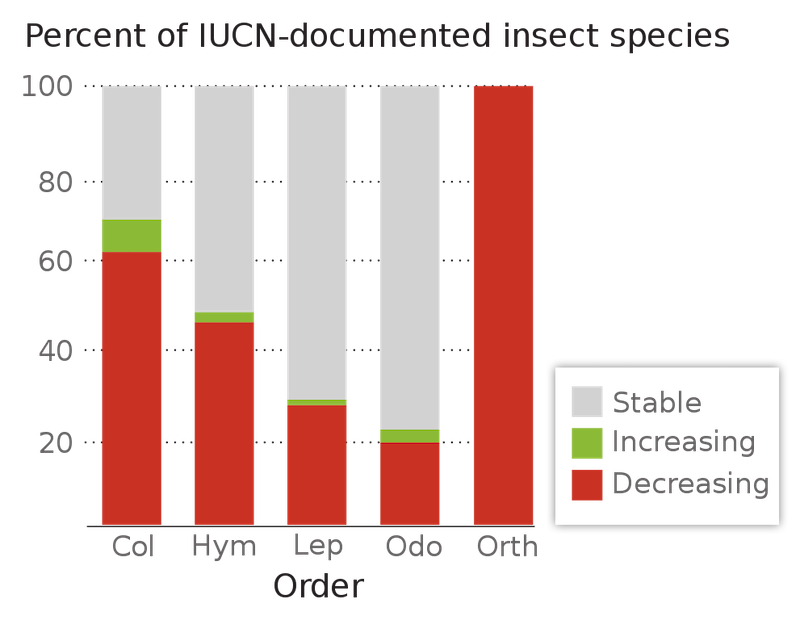
Population changes of five insect orders (Coleoptera, Hymenoptera, Lepidoptera, Odonata and Orthoptera)
About 50% of Hymenoptera species (the order to which bees of all types belong) are decreasing globally.
Therefore, when ‘celebrating’ World Bee Day – however you choose to – think about the 20,000 other bee species not managed or exploited by humans, but whose numbers – and even existence – are increasingly threatened, directly or indirectly, by our activities.
I’m old and cynical … when I see anything that promotes ‘saving the bees’ which primarily or exclusively involves honey bees I consider it; a) a money making scam, b) a misguided attempt to greenwash (’beewash’) polluting activities, or c) lazy ignorance.
Or, sadly, sometimes all three 🙁 .
Save the bees … the other bees.
Notes
I made the bit up about the Bentleys 46 speaker Hi-Fi and unobtainium trim {{8}} but the performance and consequent pollution figures are genuine … as is the ’racetrack attitude’ quote and oxygen produced from their living wall, both of which are lifted directly from their website.
References
Angelella, G.M., McCullough, C.T., and O’Rourke, M.E. (2021) Honey bee hives decrease wild bee abundance, species richness, and fruit count on farms regardless of wildflower strips. Sci Rep 11: 3202 https://www.nature.com/articles/s41598-021-81967-1.
Beekman, M., and Ratnieks, F.L.W. (2000) Long-range foraging by the honey-bee, Apis mellifera L. Functional Ecology 14: 490–496.
Henry, M., and Rodet, G. (2018) Controlling the impact of the managed honeybee on wild bees in protected areas. Sci Rep 8: 9308 https://www.nature.com/articles/s41598-018-27591-y.
Knapp, J.L., Nicholson, C.C., Jonsson, O., Miranda, J.R. de, and Rundlöf, M. (2023) Ecological traits interact with landscape context to determine bees’ pesticide risk. Nat Ecol Evol 7: 547–556 https://www.nature.com/articles/s41559-023-01990-5.
Mallinger, R.E., Gaines-Day, H.R., and Gratton, C. (2017) Do managed bees have negative effects on wild bees?: A systematic review of the literature. PLOS ONE 12: e0189268 https://journals.plos.org/plosone/article?id=10.1371/journal.pone.0189268.
Müller, A., and Kuhlmann, M. (2008) Pollen hosts of western palaearctic bees of the genus Colletes (Hymenoptera: Colletidae): the Asteraceae paradox. Biological Journal of the Linnean Society 95: 719–733 https://onlinelibrary.wiley.com/doi/abs/10.1111/j.1095-8312.2008.01113.x.
Phiri, B.J., Fèvre, D., and Hidano, A. (2022) Uptrend in global managed honey bee colonies and production based on a six-decade viewpoint, 1961–2017. Sci Rep 12: 21298 https://www.nature.com/articles/s41598-022-25290-3.
Orr, M.C., Hughes, A.C., Chesters, D., Pickering, J., Zhu, C.-D., and Ascher, J.S. (2021) Global Patterns and Drivers of Bee Distribution. Current Biology 31: 451-458.e4 https://www.cell.com/current-biology/abstract/S0960-9822(20)31596-7.
Rasmussen, C., Dupont, Y.L., Madsen, H.B., Bogusch, P., Goulson, D., Herbertsson, L., et al. (2021) Evaluating competition for forage plants between honey bees and wild bees in Denmark. PLOS ONE 16: e0250056 https://journals.plos.org/plosone/article?id=10.1371/journal.pone.0250056.
Schenk, M., Krauss, J., and Holzschuh, A. (2018) Desynchronizations in bee–plant interactions cause severe fitness losses in solitary bees. Journal of Animal Ecology 87: 139–149 https://onlinelibrary.wiley.com/doi/abs/10.1111/1365-2656.12694.
{{1}}: What?
{{2}}: Not significantly worse than a Toyota Hilux, “the beekeeper’s choice”. But faster.
{{3}}: Though presumably not of use of the car.
{{4}}: Which, if my maths is correct, is the amount used by one human in ~20 days. Every little bit helps.
{{5}}: A. andreniformis, cerana, dorsata, flora, koschevnikovi, laborious, mellifera and nigrocincta.
{{6}}: Note that there are other interpretations.
{{7}}: Aargh! Even the United Nations illustrate this with a photograph of a honey bee …
{{8}}: There are only 18 speakers fitted with the Naim audio system. The trim is inlaid rhodium applied with a glue made from unicorn tears.


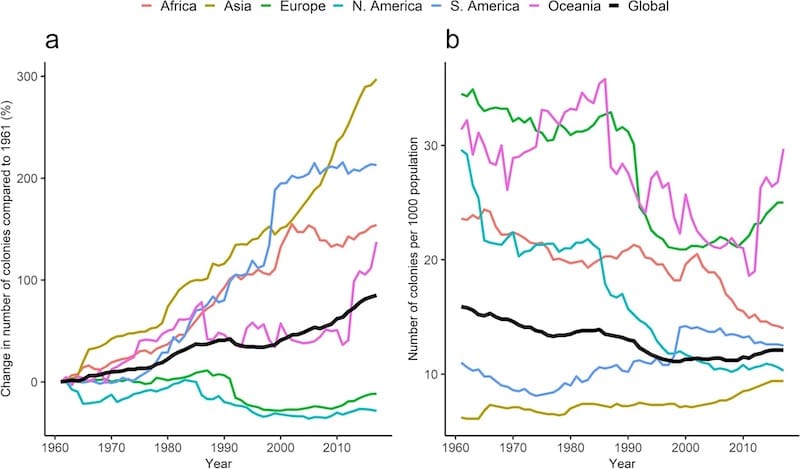

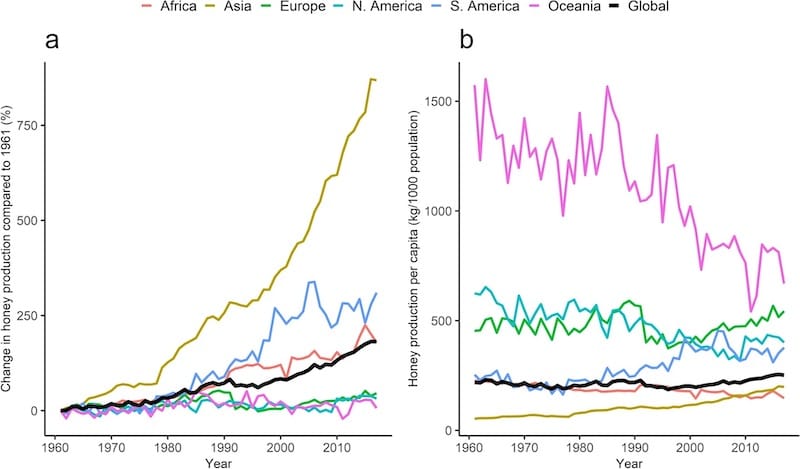
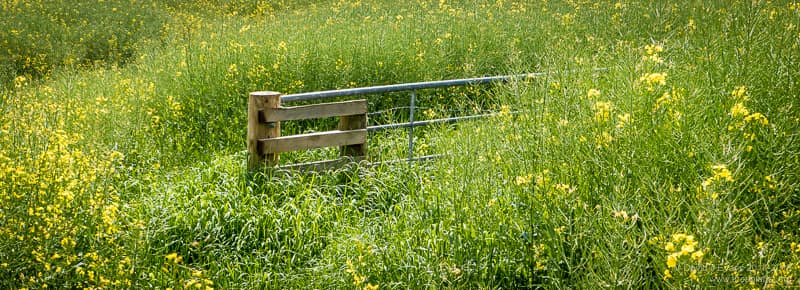
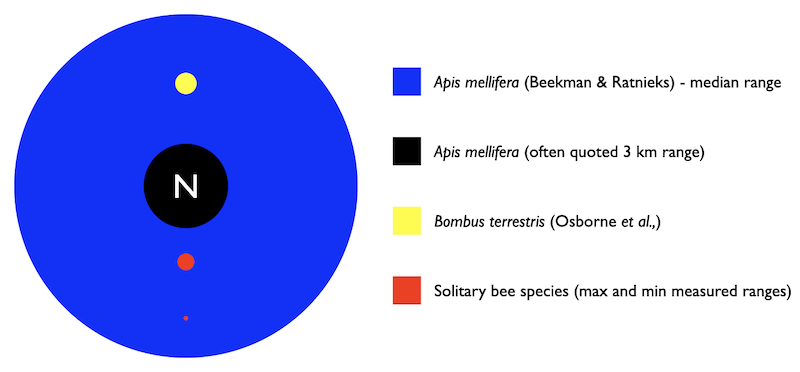

Join the discussion ...